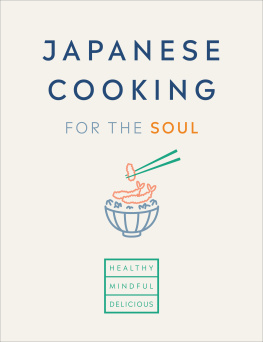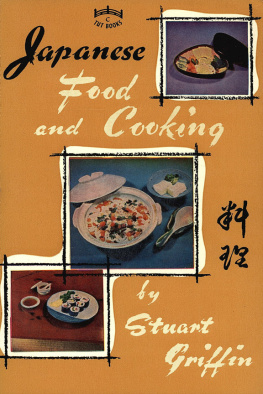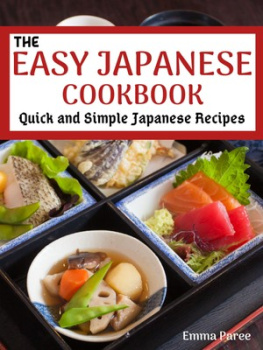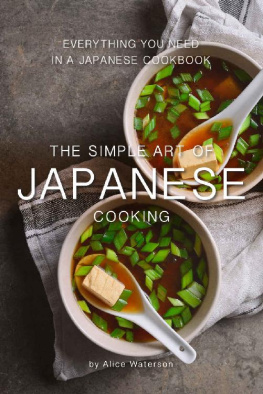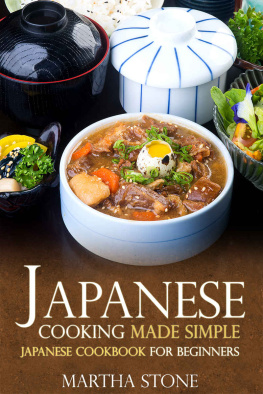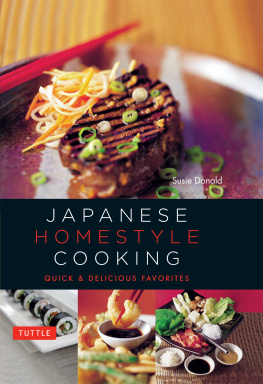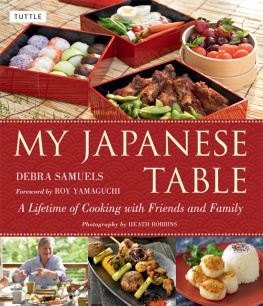Oven temperatures are for a conventional oven.
If you are using a fan oven, reduce the temperature given by 20C.
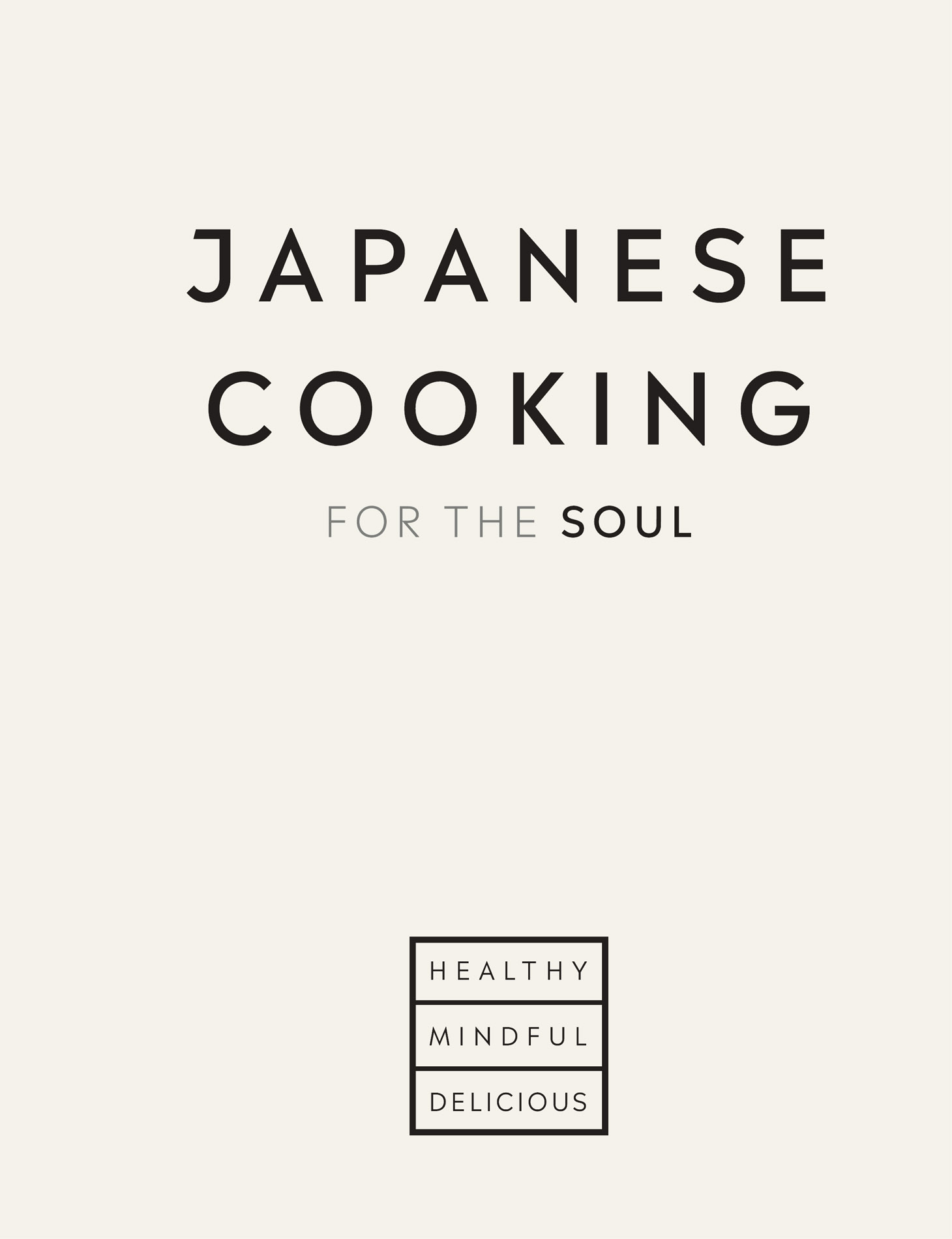
JAPANESE COOKING FOR THE SOUL HEALTHY MINDFUL DELICIOUS
This ebook is copyright material and must not be copied, reproduced, transferred, distributed, leased, licensed or publicly performed or used in any way except as specifically permitted in writing by the publishers, as allowed under the terms and conditions under which it was purchased or as strictly permitted by applicable copyright law. Any unauthorized distribution or use of this text may be a direct infringement of the authors and publishers rights and those responsible may be liable in law accordingly.
Ebury Press, an imprint of Ebury Publishing,
20 Vauxhall Bridge Road,
London SW1V 2SA
Ebury Press is part of the Penguin Random House group of companies whose addresses can be found at global.penguinrandomhouse.com.

Text Hana Group UK Limited 2020
Photography Hana Group UK Limited 2020
Illustration Hana Group UK Limited 2020
Cover Design: Two Associates
Recipe Writer: Emma Marsden
Design: Akihiro Nakayama
Photography: Howard Shooter
Food Styling: Denise Smart
Illustrator: Max Antoine Lalande dAnciger
Editor: Muna Reyal
Additional Recipe Testing: Angela Nilsen
Hana Group UK Limited has asserted its right to be identified as the author of this work in accordance with the Copyright, Designs and Patents Act 1988
This edition first published by Ebury Press in 2020
penguin.co.uk
A CIP catalogue record for this book is available from the British Library
ISBN 9781473575066
INTRODUCTION
I heard an expression in Japan that seven gods live in one grain of rice, which emphasises how important every morsel of food is and this belief is expressed in itadakimasu.
The heart of the itadakimasu ritual is one of gratitude and reflection, even if only for a moment. In its simplest form, itadakimasu is used before you receive something which is why the Japanese say it before they dine. You are receiving heavenly food, after all and, in this light, starting a meal with itadakimasu implies youll finish all of it. Something gave up its life for the meal, so it can be considered disrespectful to leave food behind. Next time you see just one last grain of rice in your bowl, dont be afraid to spend time trying to fish it out.
But the gratitude of itadakimasu reaches beyond the dinner table and into our everyday lives. Whatever you receive, be it an umbrella, flowers, bottle of wine or sake or a letter from a friend, receive it with appreciation, as the heart of itadakimasu is gratitude for the things youve been offered and a determination to make the most of what you have.
Healthy, happy and unstressed fish or animals not only taste better but offer a respect for the environment truly the spirit of itadakimasu. Buying sustainable fish not only means great-tasting sushi but importantly also ensures fresh fish for future generations. We use long lines on our fishing boats to avoid dragging up the sea bed, bird scarers to avoid trapping albatross and other large birds, GPS tracking to ensure we only fish in sustainable waters, and round hooks to avoid the by-catch of turtles as we care as passionately about the environment as we do about food quality.
We wonder about the longevity of Japanese island inhabitants, which is believed to be secured through a sense of community, keeping active, reducing stress and eating well. Japanese food can also be incredibly good for you.
Healthy, fresh and fun, sushi provides effortless and delicious nourishment for your body. This Japanese delicacy consists of rice, seasoned with vinegar, and is most commonly combined with fresh fish and/or vegetables. Low in saturated fats and sugars, sushi can provide a wholesome, balanced meal with a number of health benefits. Oily fish such as salmon and tuna are excellent sources of protein, selenium and omega-3 fatty acids, which are essential for the good function of the brain and cardiovascular system. In addition, research has shown that omega 3 can help improve mood and memory. Fresh vegetables such as cucumber and avocado contain a variety of essential minerals and vitamins. The seaweed, nori, is high in iodine which helps to regulate metabolism. Finally, accompanying ingredients such as ginger and wasabi are rich in antioxidants, helping to protect the skin and improve immune function.
So many amazing ingredients have been discovered in Japan, such as miso, which is made simply from soy beans, salt and often with the addition of rice or barley. Miso is made by fermenting those ingredients, turning starch into sugar. The fermentation is started by koji, that prized fungus grown on rice, barley or beans and the same method is used to make soy sauce or sake.
Miso is a great source of minerals and proteins and cholesterol-lowering compounds. The fermentation boosts the antioxidant levels of the soy beans (isoflavones, an antioxidant, is unique to soy beans).
A dash of soy sauce adds zest but should be used carefully so as to control your salt intake while Japanese food can be good for you and we appreciate its flavours, part of itadakimasu is also in respecting the ingredients.
Despite its simplicity, the cuisine is extremely refined and varied. I have immersed myself in ramen, teppanyaki and sushi over the last three years, though I have spent most of my career in French restaurants, and I remember a Japanese chef who taught me about perfection and respect for ingredients. This appreciation that I discovered in Japanese cuisine has been profound (though I find similarities in a European kitchen, where bones would be chopped, roasted and simmered with water and vegetables to make a stock in Japan, dried skipjack and seaweed is used to make dashi, which is also stock, but both offer deep and complex umami flavours). Some of the recipes in this book have also been influenced by other cuisines, for example, the Hawaiian poke, and the Chinese-inspired gyoza and dim sum, which have become part of Japanese food culture.
We dedicate this book to those talented chefs and to itadakimasu that originates from Japans heritage in Buddhism, which teaches respect for all living things. This philosophy extends to meals in the form of thanks to the plants, animals, farmers, hunters, chefs, foragers and everything that went into the meal.
Happy cooking and happy rolling
Jason Lalande dAnciger
Managing Director, Hana Group UK & Ireland
OUR GUIDE TO JAPANESE INGREDIENTS
AONORI a powdered, flaked seaweed that is often sprinkled on the outside of an inside-out roll to provide both flavour and texture. You can achieve a similar result by chopping a sheet of nori (see right) and then whizzing in a blender (it needs a very sharp blade though) to blitz the pieces more finely.
DASHI POWDER used to flavour ramen broth, its made from kombu (dried kelp) and dried bonito (a type of tuna) to give that unique umami savoury taste.
EEL SAUCE this is a thick and syrupy sauce but doesnt actually contain any eel its associated with the fish as its used to cover it. Its made with soy sauce (of course), sugar and a thickener. Lots of Japanese use brown sauce instead of this!
IKURA roe from salmon that is slightly bigger than tobiko (see entry, right). Ranging from reddish orange to dark orange, this provides a pop of colour on top of the Wasabi Ebi on . Theres an essence of fish and salt about them with a delicate oily texture.
Next page
